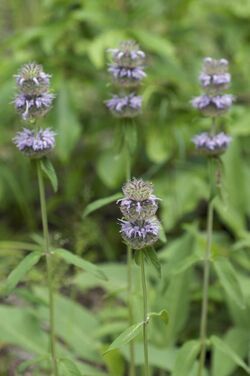Biology:Blephilia
| Blephilia | |
|---|---|

| |
| Downy pagoda-plant (Blephilia ciliata) | |
| Scientific classification | |
| Kingdom: | Plantae |
| Clade: | Tracheophytes |
| Clade: | Angiosperms |
| Clade: | Eudicots |
| Clade: | Asterids |
| Order: | Lamiales |
| Family: | Lamiaceae |
| Subfamily: | Nepetoideae |
| Tribe: | Mentheae |
| Genus: | Blephilia (L.) Raf. |
Blephilia, the pagoda plant or wood mint, is a genus of four species of flowering plants in the family Lamiaceae. They are all herbaceous plants native to eastern North America.[1][2] Blephilia are most often found in open areas, glades, and mesic forests. All species of Blephilia are considered threatened or endangered in some states. [3] [4][5] [6]
The genus includes only perennial species that spread by both seeds and through stem division. Small white to purple-lavender flowers occur in inflorescences that cluster in the upper leaf axils, often in several circular layers (hence the common name pagoda-plant). Leaves are generally lanceolate to ovate and vary in shades of green. Leaves are either petiolate or subsessile (depending on the species).[5] Like many other members of the subtribe Menthinae, all parts of Blephilia are highly aromatic when crushed and have smells similar to menthol and spearmint.[citation needed]
Species
- Blephilia ciliata (L.) Benth. – downy pagoda-plant – widespread from Texas and Florida north to Quebec and Ontario
- Blephilia hirsuta (Pursh) Benth. – hairy pagoda-plant – widespread from Texas and Georgia north to Quebec and Ontario
- Blephilia subnuda Simmers & Kral – Cumberland pagoda-plant – endemic to northeastern Alabama
- Blephilia woffordii Floden - Wofford's pagoda-plant - endemic to central Tennessee
References
- ↑ "Blephilia". World Checklist of Selected Plant Families (WCSP). Royal Botanic Gardens, Kew. http://wcsp.science.kew.org/namedetail.do?name_id=22440.
- ↑ "Blephilia", County-level distribution maps from the North American Plant Atlas (NAPA) (Biota of North America Program (BONAP)), 2013, http://bonap.net/NAPA/TaxonMaps/Genus/County/Blephilia
- ↑ "Blephilia". Natural Resources Conservation Service PLANTS Database. USDA. https://plants.usda.gov/core/profile?symbol=BLEPH5.
- ↑ Blephilia, Lady Bird Johnson Wildflower Center, University of Texas at Austin, http://www.wildflower.org/plants/result.php?id_plant=BLCI, retrieved July 16, 2007
- ↑ 5.0 5.1 Simmers, Richard W.; Kral, Robert (1992). "A New Species of Blephilia (Lamiaceae) from Northern Alabama". Rhodora 94 (877): 1–14. ISSN 0035-4902. https://www.jstor.org/stable/23313168.
- ↑ Floden, Aaron; Schilling, Edward (2020). "A new stenoendemic species of Blephilia (Lamiaceae: Lamioideae; Menthinae) from the Interior Low Plateau of Tennessee". Phytotaxa 442 (2): 101–110. https://www.biotaxa.org/Phytotaxa/article/view/phytotaxa.442.2.5.
Wikidata ☰ Q3243610 entry
 |

